The polka dot plant (Hypoestes phyllostachya) is a cute, easy care plant prized for its brightly colored foliage. This plant adds a cheerful, bright spot anywhere it is planted. It is often sold as an attractive outdoor bedding plant or small perrenial bush, but also works well as an indoor plant.
This perennial plant has splashy colorful foliage and is native to Madagascar. It thrives in tropical and sub tropical plant zones. It also grows well as an annual outdoors in temperate or colder regions.
Our care guide will give you all the tips for success with this pretty plant. We also cover polka dot plant propagation which is very simple to do.
This popular plant is available in several hybridized looks. And there are more being developed all the time. Keep an eye out for the color and leaf patterns you love.
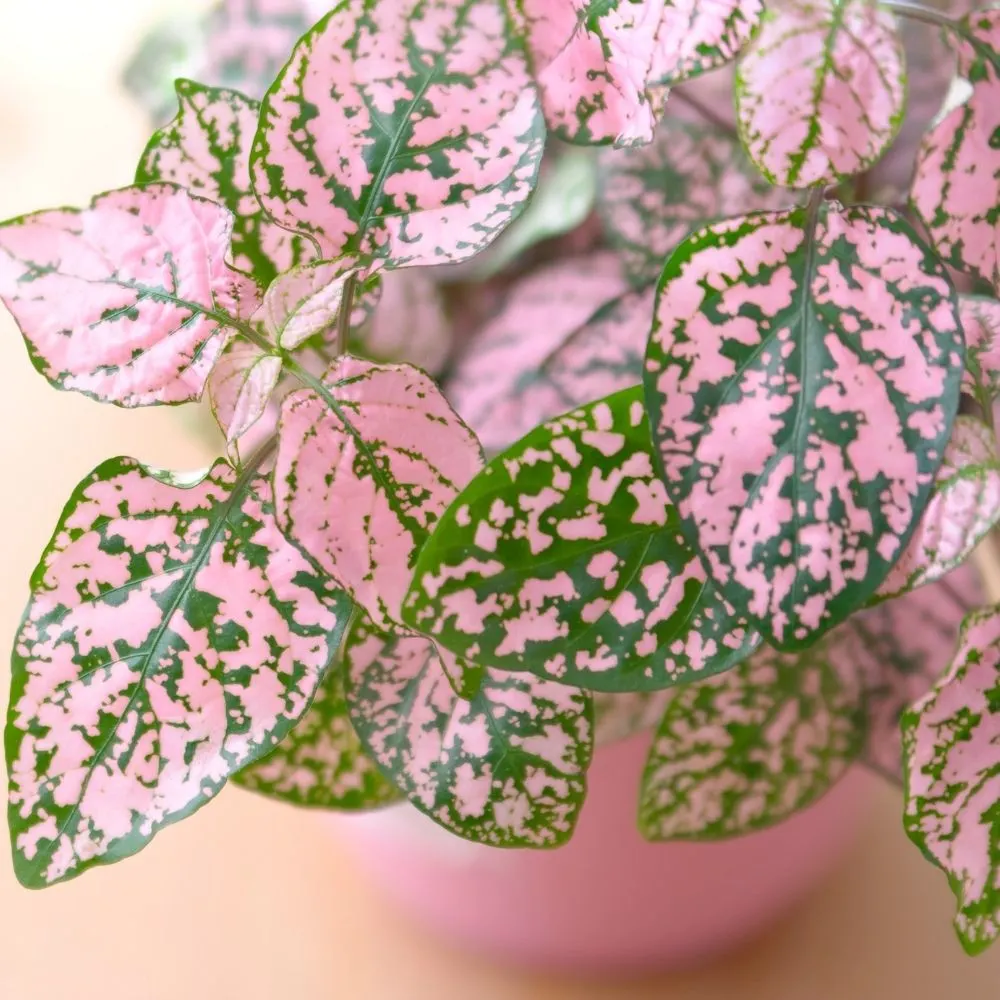
Indoors these pretty plants are easy to manage. You will need to keep pinching them back to whatever size you desire. With proper pruning they will be an adorable bushy plant you will enjoy in your home.
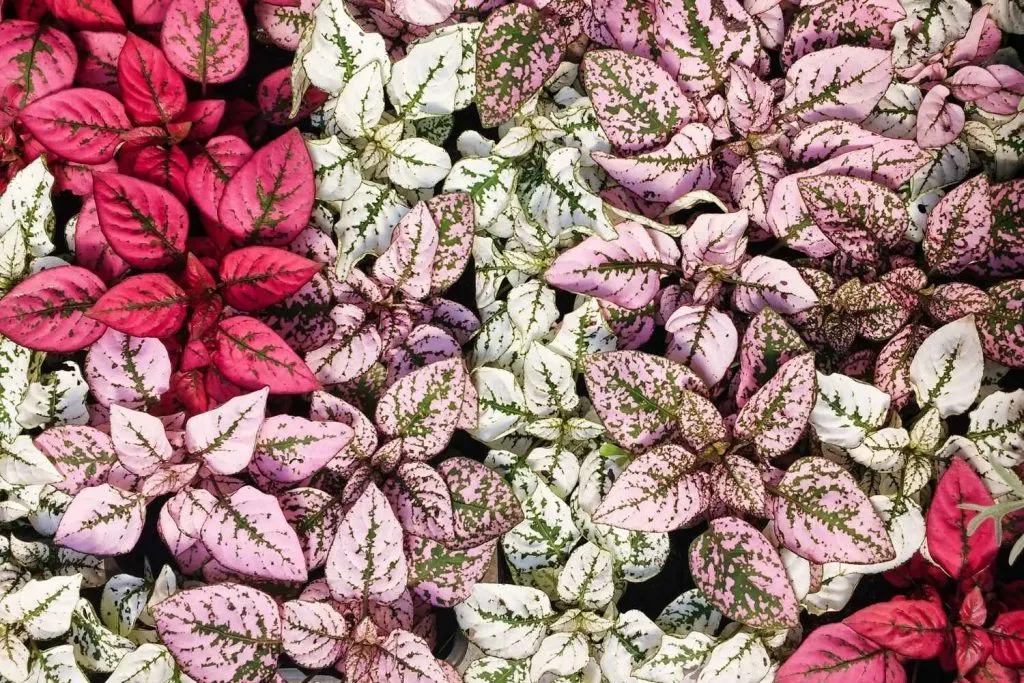
Growing Polka Dots Plants Indoors:
Polka dot plants do well indoors as houseplants year round. You can expect them to give you a couple of years of bushy, brightly colored foliage in the home.
Find the freckle face a good moderately lit spot and water it when it is dry. Trim off the flowers and leggy stems to encourage strong, bushy vibrant color and thrifty growth.
These are very easy care plants indoors. But all plants need some care. They are living beings and have basic requirements for healthy living. Just like we do.
When stressed, Hypoestes is susceptible to powdery mildew and root rot. They enjoy humidity and warmth but do not mist the leaves. Overwatering will encourage fungus gnats and root trouble in most plants. Freckle face is no exception.
PESTS: Be sure to check any new plants you bring home for pests and isolate them for one month away from other plants. This way you can be sure you don’t have unwelcome hitchhikers coming home with the plant.
Polka Dot plants pests are most often whiteflies, aphids, and mealybugs. Go to each link to learn how to combat these particular pests if you find them on your plants.
Where to Find Freckle Face Plants:
Freckle Face plants are usually available in garden centers in spring since they are often sold as bedding plants. If you are looking for a particular variety, want one out of season, or want to see what’s out there, Etsy shops are a great place to look.

Can Polka Dot Plant Grow Outdoors?
The colorful foliage of the Red polka dot plants make a showy display as border plants or in a large container when group planted. The red polka dots or pinks make an eye catching display when planted with the white freckle face plants.
Freckle face plants are grown as perennials outdoors in friendly climates as bedding and container plants.In climates with winter temperatures that drop below freezing grow Hypoestes as an annual.
As bushes outdoors, Polka Dot plants can grow to two to three feet. They prefer partial shade to give their most intense leaf colors. Harsh direct hot sunlight will fade the leaf colors on the freckle face.
They do well in light shade, in dappled light, cover of awnings, or in partial shade. They make a beautiful patio bush planted in a larger container either by itself or in groupings.
Polka Dot Plants flower in late summer. If the flowers are not pinched back, the plant will go to seed. After seeding out, the polka dot plants lose vitality and are pretty much done for the year.
Outdoors, freckle face plants and bushes can flower, reseed and naturalize. Be careful where you grow these in warm climates. Naturalizing can become a problem over time. Seeds can blow all over the yard and polka dot plants can get invasive when they show up where you don’t want them to grow.
These perennials are rather short lived in both indoor or outdoors. The Polka Dot plant only lives about 2 years. They often lose thrift and die after flowering. Especially if not pinched back.
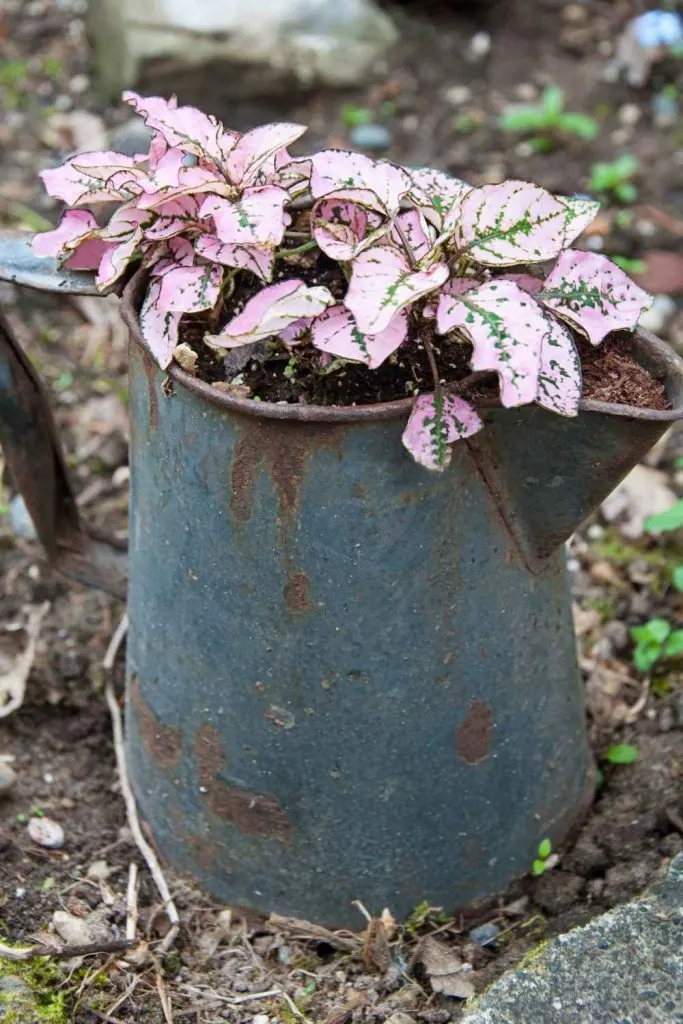
Polka Dot Plant Flowers:
Polka dot plants do flower. You can allow them to flower but be sure to cut off the tiny flowers before they go to seed.
This keeps the energy of the plant feeding the foliage. The plant will last much longer if not allowed to go to seed.
Polka Dot Plants will also flower indoors. It’s best to snip off the flowers to retain the vitality of the plant and keep it looking its best.
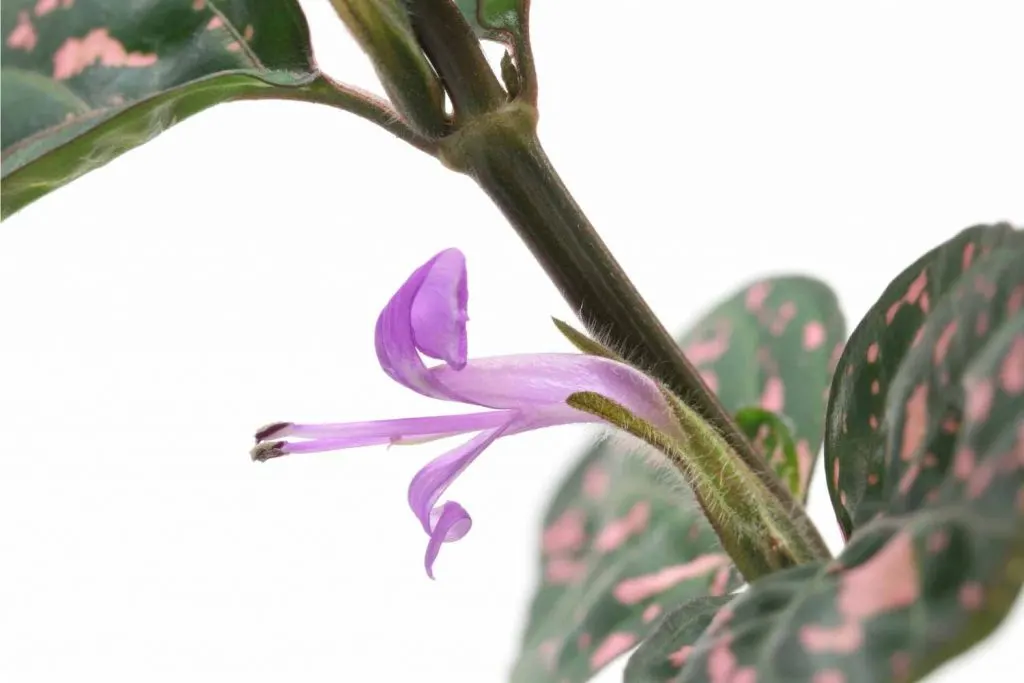
Polka Dot plant is Non Toxic to cats and dogs and Humans:
Fortunately, Hypoestes phyllostachya is pet safe and non toxic to humans as well. You still want to keep your pets and kids out of the plant. But they will not get sick from eating the stems, flowers and leaves.
How Do You Take Care Of a Polka Dot Plant?
Read our quick guide below for important facts and care tips on the Polka dot Plant. Our Printable care guide further down will go into greater detail on taking care of the Polka Dot Plant.
| Familiar Names | Polka Dot plant, Freckle Face plant, |
| Scientific Name | Hypoestes phyllostachya |
| Plant Family | Acanthaceae |
| Care Difficulty | easy |
| Temperature | 60 to 80 degrees F. |
| Watering | Water thoroughly when soil is dry down an inch or so). Freckle face plant enjoys humidity. Pebble trays, humidifiers and plant groupings work well to increase humidity. |
| Soil | 60% potting soil and 40% perlite make a good soil for polka dot. It enjoys a soil that drains well and has good organic matter. |
| Lighting | Moderate to bright INDIRECT light is optimal. The polka dot plant will grow well in lower lighting but it will get leggy as it reaches for the light and need frequent pinching back. |
| Growth | Hypoestes phyllostachya is a herbaceous perennial that grows as a small bush reaching one to two feet high. They are good candidates for group planting in outdoor planters or planted as a carpet in a shaded flower bed. Indoors plant them singly in proper sized pots so they bush. |
| Pruning: | Pruning will help polka dot stay full and bushy. Pinch it back at the leaf nodes on the stems to encourage a fuller bush. More frequent pruning is required in lower light. |
Polka Dot Plant Care Guide:
Stem cutting propagation is the same in polka dots as it is for the Pothos N Joy and Jade Plant. Watch our propagation videos on these two plants for a complete discussion of the stem propagation process.
Please also watch our care video at the bottom of this care card.
If you print out this plant care guide the pictures will not print. This is to save you paper and ink.
Polka Dot Plant Care Guide
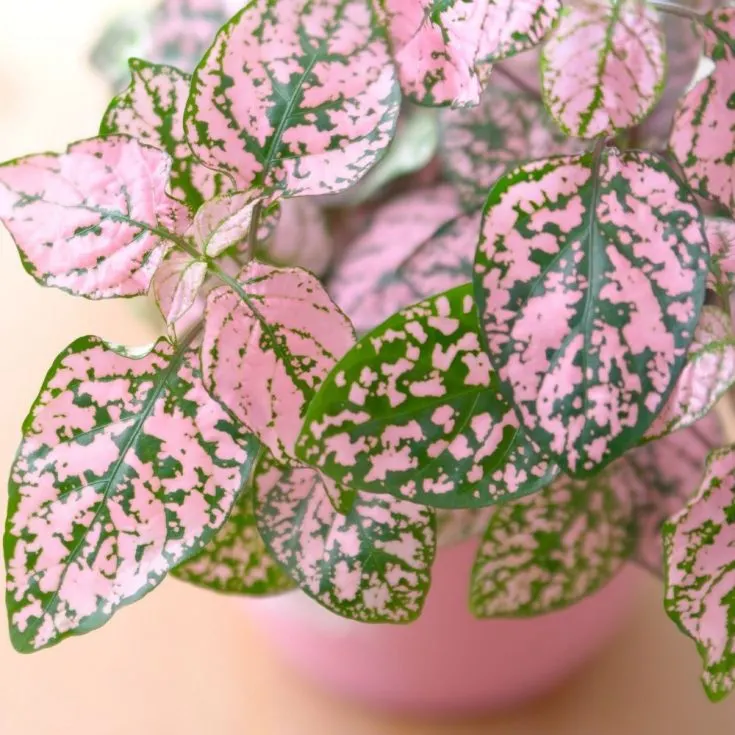
The polka dot plant (Hypoestes phyllostachya) is a cheerful addition to your home. Its cute freckled face provides a colorful accent.
Polka dot plants come in several colors. They all grow as bushy plants that make a cute table top plant. These easy care plants will also grow outside in warm climates.
This Care Guide will teach you how to keep this plant happy all through the year.
Materials
- Perlite
- Potting Soil
- mask
- Fertilizer
Tools
Instructions
Soil Preference:
- Polka dot plants prefer a rich well draining soil. The roots will rot if they sit in moist compacted soil for extended periods. Wet soils also encourage fungus gnats.
- A good potting soil and perlite mix will keep the roots happiest.
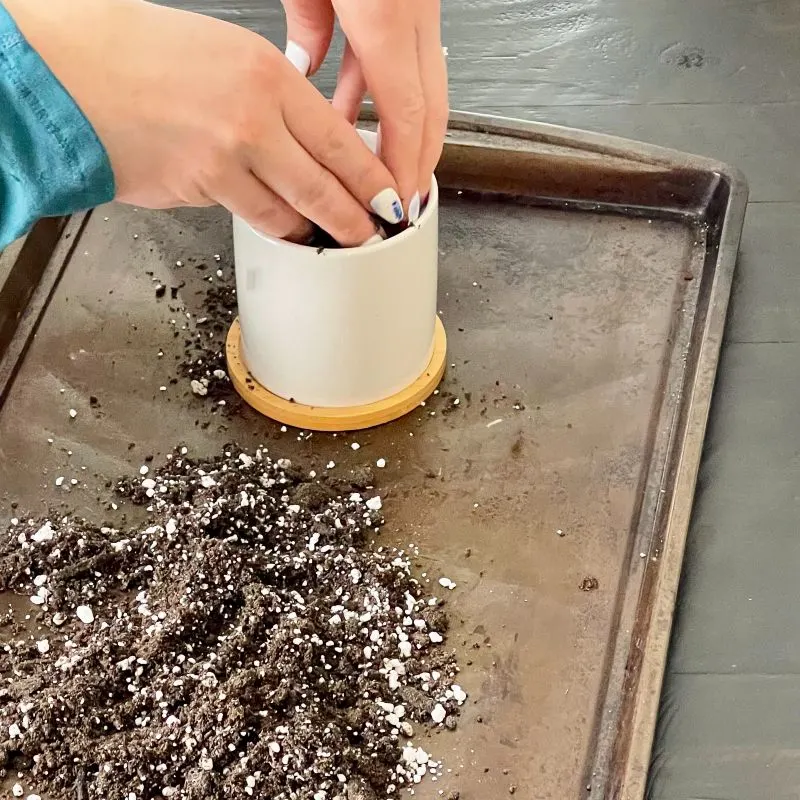
- Make sure your pot has drainage at the bottom. Do not use a pot with no drainage holes for this plant.
Pot Size and Type:
- The polka dot plant can grow in many different kinds of pots, I like to plant mine in ceramic pots with a drainage hole.
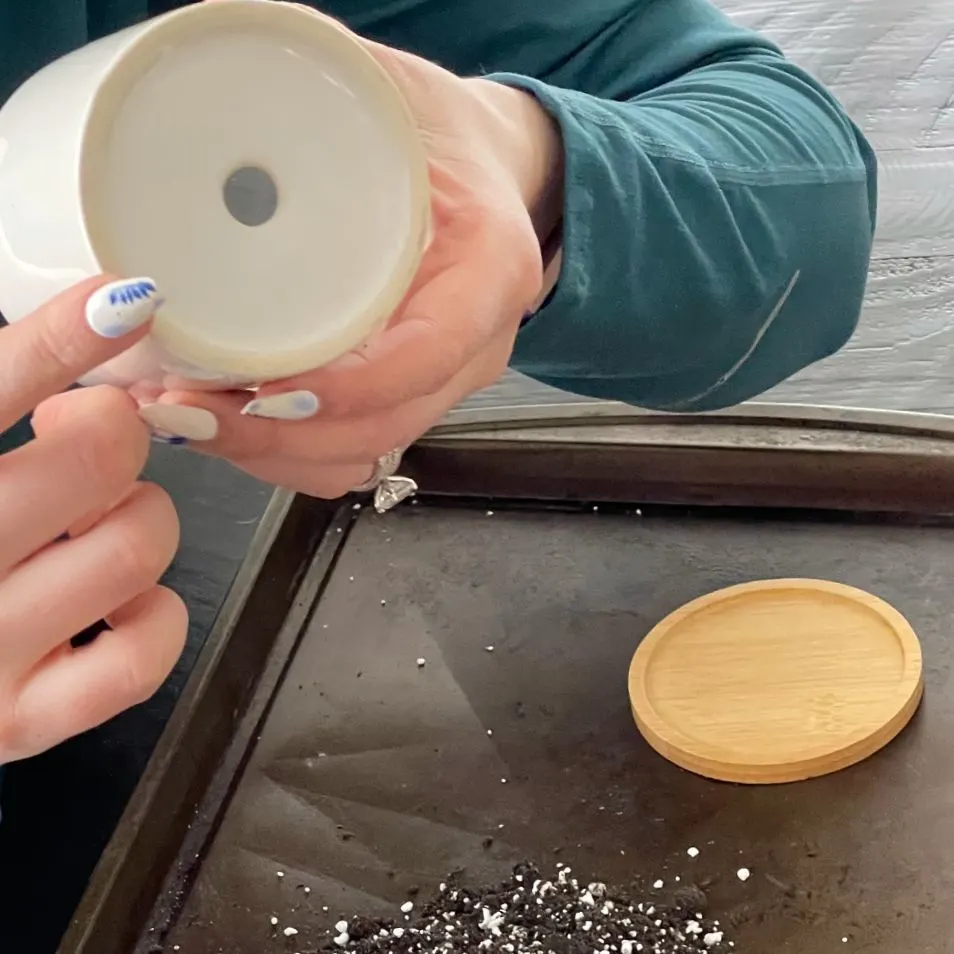
- Repot every second year or when the soil breaks down or roots come out the drainage holes on the pot bottom To the next pot size up. Don't jump to a huge pot from a small one. Just go to the next size up pot.
Lighting:
- Polka dot plants will grow well in moderate or bright indirect light.
- It will also grow in lower light conditions. The coloring on polka dots is more intense in lower light but the growth will be leggier as the plant seeks the light.
- Make sure the polka dot plant isn't sitting in constant direct sunlight. Polka dot plants will fade in intense direct light.
- Some filtered sunlight from a window will be fine with periods of direct light. Just watch the leaves. If they fade move your plant.
Watering:
- Water your polka dot plant when the soil is dry an inch down.
- Polka dots do enjoy humidity. They will benefit from sitting on a wet pebble tray, bottom watering and occasional misting.
- Watering is best done on a regular schedule so the plant is not over or under watered. Both can cause stress on the plant.
- The recommendation for watering is every 2-3 weeks.
- Brown tips may indicate watering problems.
- Never let this plant get wet feet. Heavy wet soils cause root rot and attract Fungus Gnats.
How to Fertilize:
- Apply a good quality fertilizer (linked in materials) monthly through Spring and summer.
- Decrease feedings by late Fall and allow the polka dot plant to rest through the winter months.
- Brown tips may indicate too much fertilizer. Freckle face plant is not a heavy feeder.
- It does enjoy the occasional feeding but keep the dose light. Try diluting the fertilizer by 50% for this plant.
Temperature:
- The Polka dot plant will do best in temperatures between 60-80 degrees F.
Pruning:
The polka dot plant needs frequent pinching back to keep it in good shape. This plant tends to grow leggy. Especially in lower light conditions.
- Check the plant Weekly when you water for long stems.
- Snip or pinch back any long stems down to the next set of leaves.
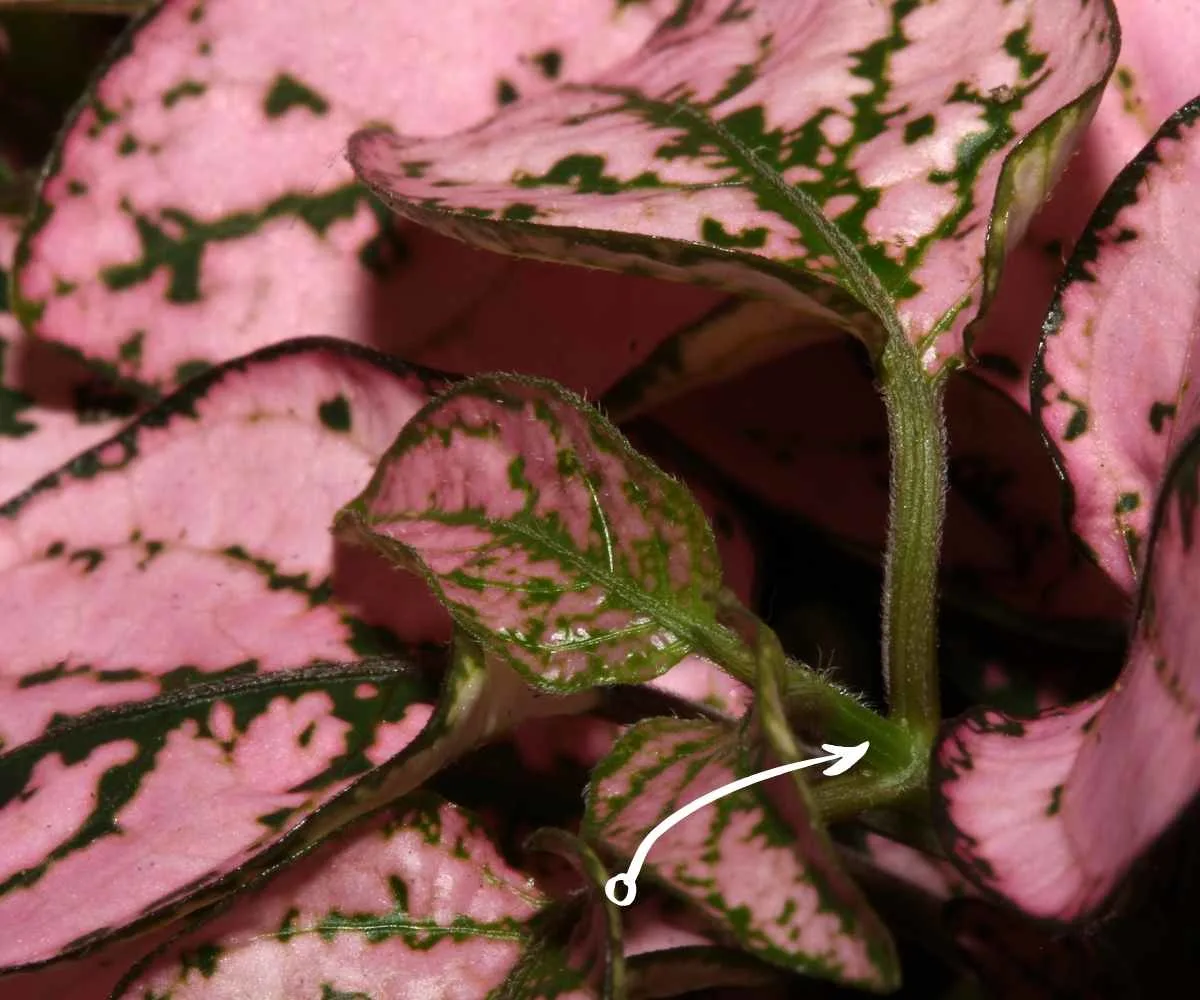
- Do NOT leave long empty stems. The stems have no way to grow leaves. Leaves grow from the nodes only. Also long empty stems can open the plant to disease.
- Regular light pruning or pinching is preferable to occasional intense pruning of several branches. Over pruning of a leggy plant will not give you the best shape.
- Pruning over 1/3 of the top growth at once can stunt the plant and cripple the root structure since it cannot be properly fed. This can lead to root rot and an unhappy plant.
Pests:
- Polka dots are hardy resilient plants. However all plants can get attacked by pests.
- Stress by longterm overwatering, poor light, extreme temperatures and soil conditions are contributors to plant stress..
- Polka dot plants are most susceptible to mealy bugs.
- If you see a white cottony mass on the leaves or the white fuzzy mealy bug dip a cotton swab in rubbing alcohol and touch the bug to make it fall of the plant.
- Spider mites, mealy bugs, scale, thrips and whitefly are the most common houseplant pests you will see on all plants.
- Read our post on How to get rid of aphids and other pests with our homemade pesticide soap recipe or neems oil.
- To minimize the possibility of pests be sure to check all nursery plants before bringing them home.
- Quarantine all new plants until you are sure no pests live in them.
Non Toxic to cats and dogs and Humans:
Fortunately, Hypoestes phyllostachya is pet safe and non toxic to humans. You still want to keep your pets and kids out of the plant. No telling what is in the plant soil.
But they will not get sick from eating the stems and leaves.
How to Propagate:
- Propagation is by stem cuttings (it naturalizes outdoors by seed as well).
- Cut a long stem and strip off all but the two top leaf groups.
- Set the cuttings into water or wet soil.
- In several weeks it will root.
- Plant the water cuttings when the roots are an inch long or so.
- Pothos N Joy by stem cutting. The Process is the same for the freckle face plants.
Notes
The Polka Dot Plant is a rewarding plant. This plant will grow cute and bushy with just a little bit of care. Perfect for houseplant beginners
More Easy Care House Plants:
If you looking for easy care indoor plants, check these out!
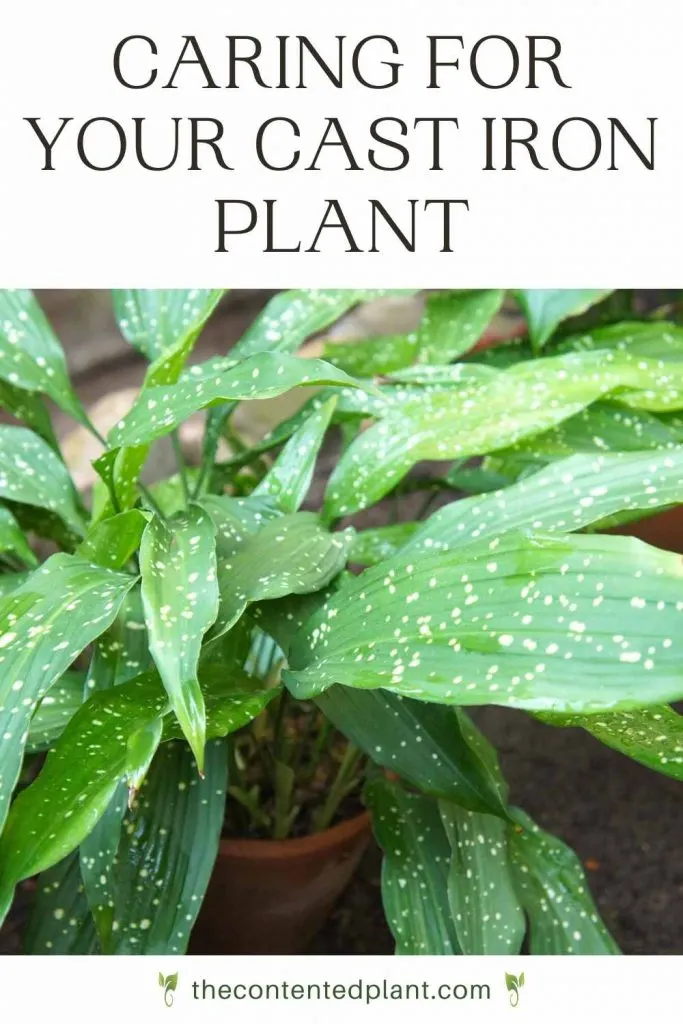
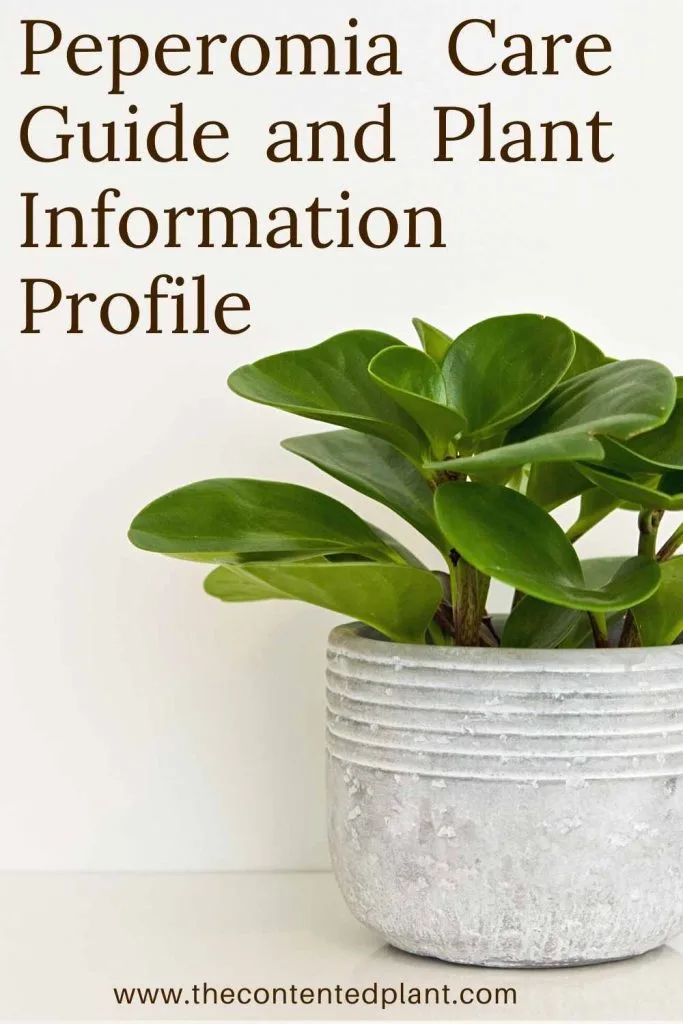
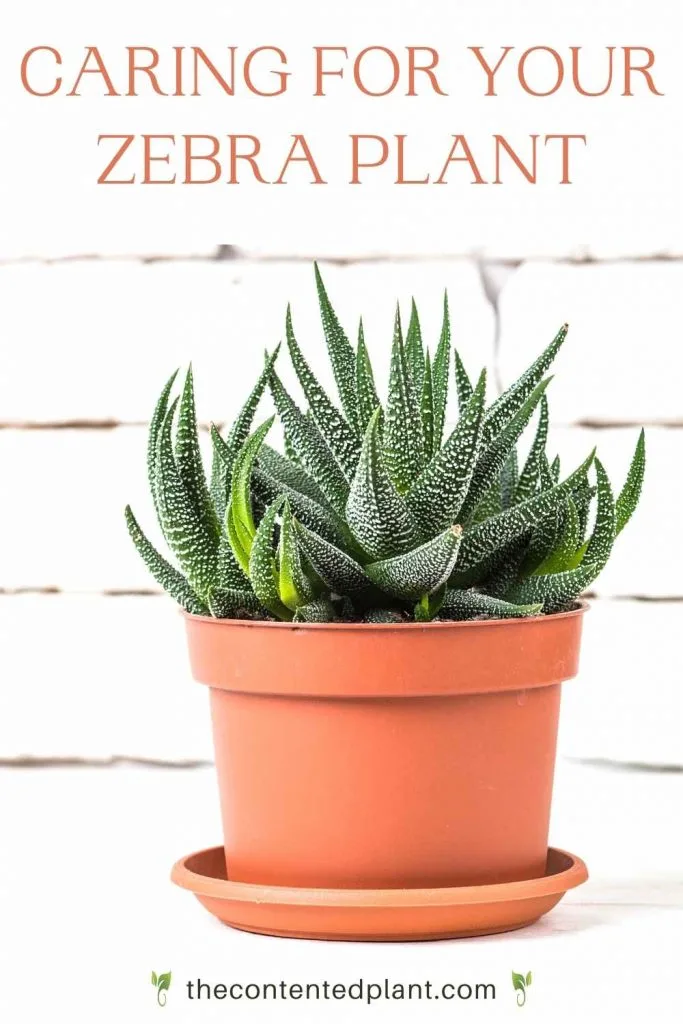
Follow Us:
Find us on YouTube, Instagram , Pinterest and TikTok! We love to Plant chat. We also comment, like and occasionally share your content to our daily stories. We’d love to see your plants. Share your joy in your houseplants. Happy Planting!

Coleus Varieties for Sun or Shade - The Contented Plant
Thursday 25th of August 2022
[…] should be pinched back (like the polka dot plant) if you want the foliage to be bushy. Coleus tend to get […]
Nerve Plant Care Guide and Profile - The Contented Plant
Monday 1st of August 2022
[…] Polka Dot Plant […]
Baby Tears Plant Care Guide - The Contented Plant
Wednesday 18th of May 2022
[…] Polka Dot Plant […]
How to Get Rid of Powdery Mildew on Plants-Treatment Guide - The Contented Plant
Friday 18th of March 2022
[…] Polka Dot Plant Care Guide […]
Begonia Maculata Care Guide and Tips - The Contented Plant
Friday 23rd of July 2021
[…] plant is often called a polka dot plant. Not to be confused with the Hypoestes Phyllostachya . Which is also commonly known as a Polka Dot plant. They are very different […]